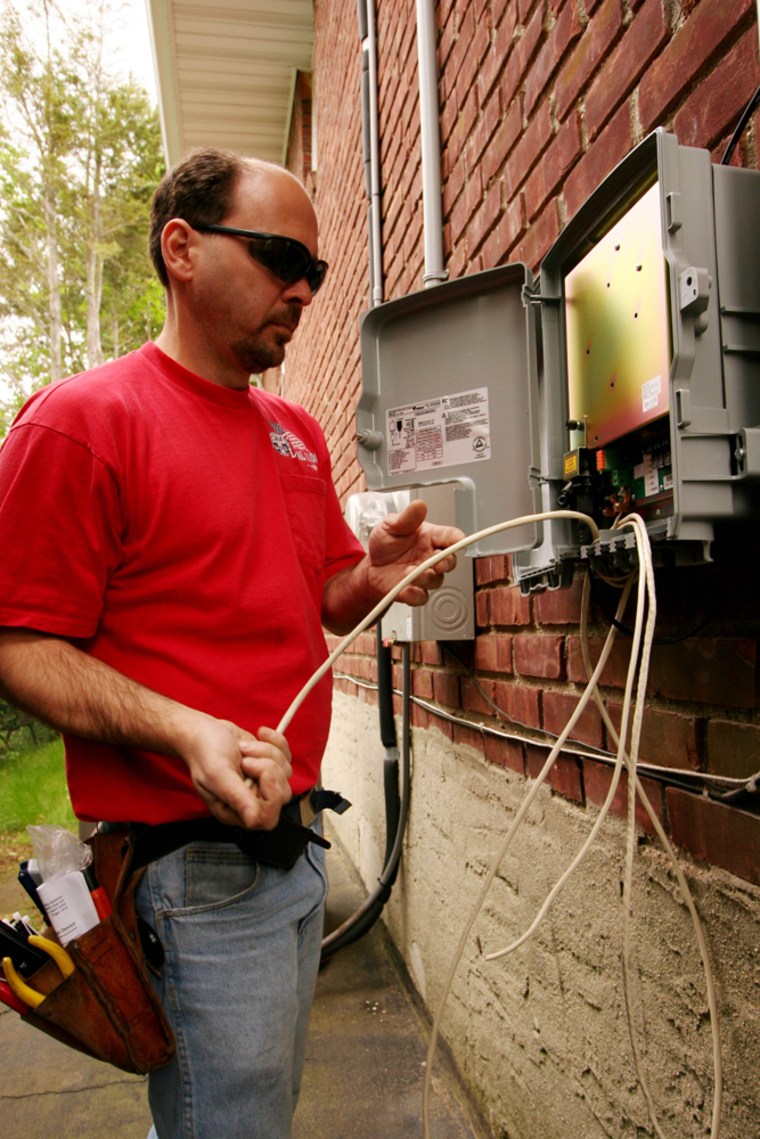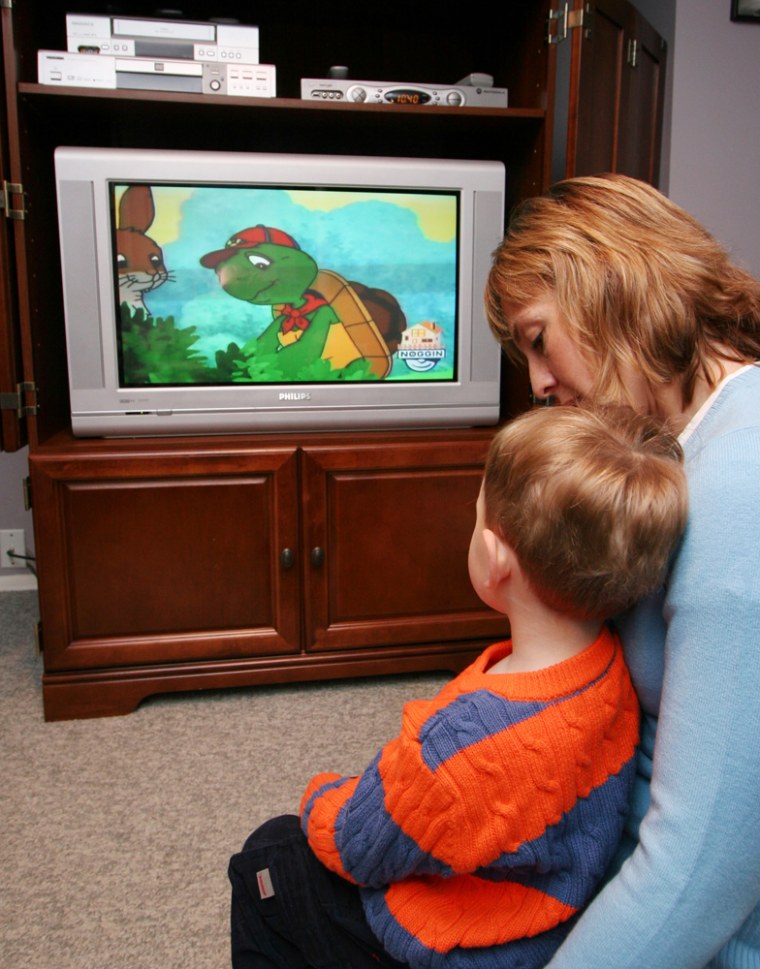Lisa Donohue squats on the floor with her 2-year-old son Calum in front of their high-definition TV, watching a children's cartoon.
"What kind of animal is Franklin?" she asks him. Calum is a little under the weather, and his eyes droop a bit, but they stay fixed on the turtle on the screen.
Calum probably doesn't know, but the image of Franklin's bright green skin is brought to him not by cable, satellite, or broadcast, but by pulses of light that go straight to his home here on suburban Long Island from a telephone-company building miles away, via optical fiber.
Optical fiber — strands of glass 15 times thinner than a human hair — have been used by telecommunications companies over long-haul routes since the 1980s.
Now Verizon Communications Inc. is making a big and expensive bet on replacing the network of copper wires that has provided phone service since the 19th century with fiber, giving it the capability to carry TV and super-fast Internet service in the bargain.
Investors have been skeptical of the plans, sending Verizon's stock down by about 20 percent since the rollout started last year, and other phone companies have not made the same gamble. Donohue, however, is happy with the service Verizon calls FiOS.
"With cable, the picture would stop. Or we'd have those digital things going," she says, gesturing to mimic the picture breaking up.
"We could get satellite, but our only tree in the garden is in the southwest corner, so we'd have to chop our only tree down" to get a clear line of sight to the satellite, she says.
The family pays about $220 a month for TV, phone, high-speed Internet service and two cell phones, which she says is cheaper than what they were paying before, when they had cable.
"It comes as one bill, which is nice because I don't have to remember to pay four times," Donohue says.
Factors like that have made Verizon's FiOS TV a success in the few areas where it's available, judging by Verizon's data. It has said that 6.5 percent of households in Massapequa Park signed up for TV in the first three months after its launch on Jan. 24. That figure is disputed by Cablevision Systems Corp., the incumbent cable company, which said it had a net loss of less than 2 percent in the area.
Verizon has permission to sell TV service in about 80 communities in New York, Florida, Massachusetts, Maryland and Virginia. It has fiber available for phone and Internet service in many more _ 3 million homes. Verizon doesn't say how many homes are connected, but analysis of a tally by research firm RVA LLC indicates that Verizon had about 400,000 homes connected as of April.
"This is a once-in-a-lifetime project," said Paul Lacouture, Verizon's vice president of engineering and technology.
Chief among fiber's advantages is its almost unlimited capacity to carry information, which Verizon only nibbles at with its current system: It lights fiber to the home with just three laser beams, though the fiber can carry many more.
The single beam that carries video (the others carry data and telephone calls to and from the home) has more capacity than an entire coaxial cable of the kind used by cable companies.

In practical terms, that means better image quality, because the digital TV channels don't need to be degraded to save bandwidth.
"If you're watching a program, you see the faces elongate, smear out" on digital cable, says Alex Fazi, who as owner of a videography studio in nearby Wantagh has a keen eye for video quality. He said he'll sign up for fiber TV as soon as it's available in his area.
In a similar way, fiber provides almost limitless Internet connection speeds. With current technology, Verizon could provide download speeds of 644 megabits per second, a bigger step up from DSL at 1.5 mbps than DSL is a step up from dial-up.
But for now, the maximum speed Verizon sells is 30 mbps for small businesses, or 20 mbps for homes.
"Right now there are not a lot of applications online that demand 100 megabits," Lacouture said. That's true, but probably in large part due to the lack of home connections at that speed — a chicken and egg situation.
Speeds may be going up soon, though: Verizon already raised them once (from 5 mbps to 10 mbps at the lowest tier) in New York, New Jersey and Connecticut — the three states where it competes with Cablevision, a technologically sophisticated company that provides downloads at up to 30 mbps.
Apart from capacity, fiber has the advantage of being immune to interference and crosstalk, and nearly immune to rain, which can cause problems on the phone network.
"Customer reports have dropped by a factor of four or five when we've replace the copper with fiber," Lacouture said.
Verizon expects to cut costs for its outside equipment by 40 percent by switching to fiber. But to get there, it has to spend big.
Verizon's average cost of pulling fiber down a street was $1,400 per home at the beginning of last year, not including the cost of actually connecting the homes. The target cost this year is $890 per home, reflecting improvements in materials and techniques. If it reaches its target of laying fiber by another 3 million homes by the end of the year, that's a cost of $2.7 billion — about half of Verizon's annual earnings.
Verizon is in essence taking the lumps as it blazes a trail for large-scale fiber deployment in the United States across its 28-state territory — it's creating the demand for equipment that allows manufacturers like Motorola Inc. and Tellabs Inc. to bring down costs.
"Every month that goes by we see another improvement," Lacouture said.
A large part of the cost, however, is labor, which doesn't get cheaper by the month. Drawing fiber along a street involves digging a trench to lay it, or putting up plastic tubes on the utility poles, then pulling the fiber through the tubes.
Paul McIlrary, Verizon's area manager for outside plant construction around Massapequa, says his teams of about three people lay fiber at a speed of 25 feet to 35 feet per day in the dense Long Island suburbs. That may sound slow, but McIlrary has 90-110 linemen working to lay fiber just in Freeport, which has 45,000 inhabitants.
"With fiber, it's a light source, and any bend can distort the signal," McIlrary says. "So we have to be careful that we don't bend or kink it."
Other than that, the actual placing operation isn't much different from copper, which Verizon's people have a lot of experience with.
Home installation is another cost: the target here is $715 this year, but Verizon has acknowledged that costs are running above that target. It's a big job, at least if TV service is involved. It took the installer all day to get the Donohues up and running, for instance.
Getting a "drop cable" with fiber to the home from the nearest utility pole is the small part. The installer then attaches a large box, called an Optical Networking Terminal, to the side of the house. On the other side of the wall, he installs a backup battery, which should keep the ONT running for six hours if there is a blackout.
Then he strings coaxial cable from the box to the TV sets (Verizon will use existing coax if it's not substandard), Ethernet cable to an Internet router, and a phone line to handsets. In addition, a small box called a Network Interface Module is installed inside that needs to connect both to the coaxial and Ethernet cables.
With costs like that, it's perhaps no mystery why the other big telephone companies, like AT&T Inc. and BellSouth Corp., are focusing on upgrading their copper DSL lines rather than bringing fiber to the home (though they do draw fiber in new subdivisions). But analysts believe the DSL upgrades are stopgaps, and that the other companies will eventually move to fiber in a few years. By that time, Verizon's efforts may have made the process simpler and cheaper.
"People talk about the risks of doing this," says Michael Render, who tracks fiber buildouts for RVA, the research firm. What they should be talking about, he says, is the risk of not building out fiber. "The world is changing very rapidly."
